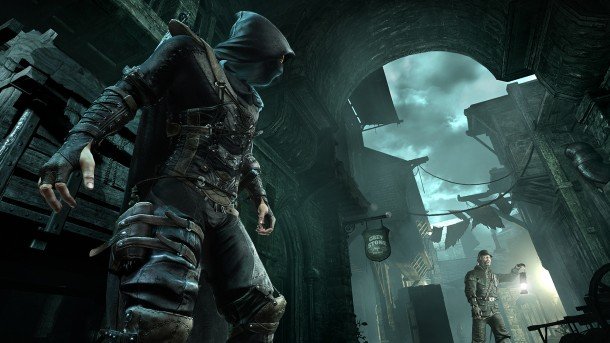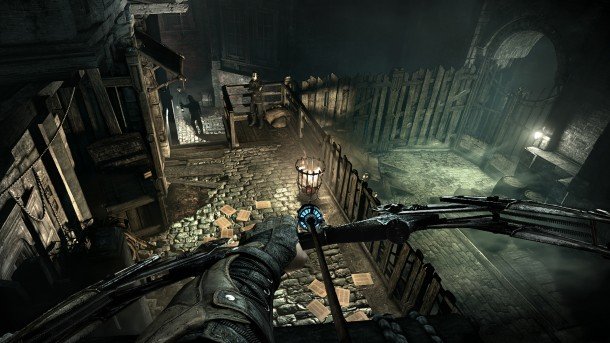Thief preview: how I remembered the series wrong

Thief is about a guy with a bow, Garrett, who steals stuff. That's definitely what the series is about, and that's how I approached my first look at Eidos' reboot last week at GDC. It better be about a guy with a bow who steals stuff, because aren't we all afraid Thief will mess with those fundamentals?
Eidos knows this fear. When I asked a group of devs what they thought Thief fans were most worried about, they all said "that it'll be too easy." They told me their intentions are pure. They want Thief to be a Thief game, they say.
But it isn't enough to say "Make it just like the first Thief!"
A game just like Thief: The Dark Project would look like a game from 1998, and the new Thief looks like a very expensive modern game which needs to appeal to more than one niche to be financially successful. That's impossible to do without pissing anyone off, but we have a responsibility here, too. We have acknowledge that how we remember The Dark Project and its sequels has been distorted by time.

At least, it has for me. My memories, for instance, glazed over much of the magic. When I saw that metaphysics are back in the new Thief, introduced as a mystical amulet Garrett steals, I thought, "What's this? Thief is about a guy with a bow who steals stuff."
No, it really isn't. Classic Garrett? He talks to ghosts . And when, at first, I thought the new pre-industrial revolution setting was out of place, I remembered that Thief has always been ambiguous about when and where it takes place—it's always changing, as it did in Thief II: The Metal Age. I kept saying, "Oh yeah," like a faded dream was resurfacing.
I was seeing a gut expectation, the flawed fear that modern things exist only to taint the good things from the past. That's not fair. Thief deserves a chance to prove itself.
The biggest gaming news, reviews and hardware deals
Keep up to date with the most important stories and the best deals, as picked by the PC Gamer team.
As you've probably seen, yes, you do play as Garrett, a master thief with a bow and a selection of utility arrows (as well as regular, pointy, killing arrows). You execute missions in The City, a place which exists outside of human history. You can play the whole game without being detected, or you can choose to pepper your capers with violence. You can whack people over the head with a blunt, leather-bound blackjack. Light is still important, and you can still use water arrows to extinguish flames. All that Thiefiness is there, but a lot has changed, too.

Garrett has a new voice, because Eidos decided to go with performance capture, which means voice and movement are recorded together. This was a controversial decision, but understandable. Performance capture is how Crysis 3's Psycho looks so lifelike when he talks—it works—and lifelike, convincing characters are especially important for Thief, because we'll be relying on our ability to read our victims' level of alertness as we sneak about stealing their pocket watches.
Or, we ought to be. The stealth mechanics were hard to judge in the staged demonstration I saw—I'll have to play it to know how well character animation communicates the vision cones we're meant to avoid. I'd like it to work, because I want to play a stealth game in which in-scene cues gives us ample situational awareness, lessening the need for a HUD or other overlay hints.
We'll also be doing a lot of eavesdropping, which means a lot of faces doing a lot of talking—the decision to use performance capture makes more sense. Garrett is a bit of a voyeur, and in the demonstration, he creeps through an opium infused brothel party, listening and watching as he nicks valuables from degenerates. I was worried by how close he could get to party-goers while crouched in shadows—I mean, they're high, but not blind, right?
Another thing I have to take Eidos' word on is freedom. The demonstration was steered with such precision—every candle was snuffed at the right time and all the right dialog was overheard—that I didn't get a picture of what the other paths are. I'm told there were many.

Also in the new department is a third-person view which activates when scaling walls. Actually, it isn't totally new—Thief: Deadly Shadows let us switch between first and third-person. In this case, however, it appears to be a utilitarian choice to make climbing doable, and 95 percent of the demonstration was from the perspective we love.
It's that traditional first-person view that puts us directly into Garrett's shoes, making his close calls ours. Especially effective are his hands, which grip the corners of furniture as he peeks around it. It made me think of a sneaky little chameleon, grabbing whatever it can with its sticky claws.

They're some really good-looking hands, too. Visually, well, Thief: Deadly Shadows is almost 10 years old, so that's another bit of new. In a tech demo, I saw a scene in which every rain drop was an individual particle. I saw Garrett bolt through a burning mansion, where shadows belly danced on the walls and dynamically lit volumetric smoke rose to hallway ceilings and crawled toward open windows, leading the way. It was a particle effect sauna, impressive and luscious, despite the oppressive setting. That Unreal Engine 3 Samaritan demo is almost a real thing we can play.
Oh, and one more new thing: Garrett can slow down time. I know , and Eidos knows too. The devs assured me that his Focus ability, which can be used in bursts to make master thievery a bit easier by highlighting important objects and aiding lockpicking, pickpocketing, and combat, will never be mandatory. I don't accept the "it's not a problem for traditionalists because they don't have to use it" argument, because temptation counts as a problem, so I hope there's an option to fully disable it. The team is still figuring out what we'll be able to tweak, but I came away understanding that they know we want a lot of options.

When the demo ended, Producer Stephane Roy asked me, "So, is it a Thief game?" His insecurity is endearing. I can tell he wants to please fans, but he and Eidos have a tough road ahead. Reboots are intrinsically hard. They not only challenge the past, they challenge our perceptions of the past, and those are impossible to counter because they aren't based in reality.
The last Thief will be 10 years old when the new one releases next year. By making a new one, something beloved is being ripped from its solidified place in history to be analyzed and criticized and improved on . It'll take a lot of convincing, but Eidos showed me that they aren't dismissive of the challenge. They have fear, and that's probably a good thing.
More screenshots on the next page.

Tyler grew up in Silicon Valley during the '80s and '90s, playing games like Zork and Arkanoid on early PCs. He was later captivated by Myst, SimCity, Civilization, Command & Conquer, all the shooters they call "boomer shooters" now, and PS1 classic Bushido Blade (that's right: he had Bleem!). Tyler joined PC Gamer in 2011, and today he's focused on the site's news coverage. His hobbies include amateur boxing and adding to his 1,200-plus hours in Rocket League.

